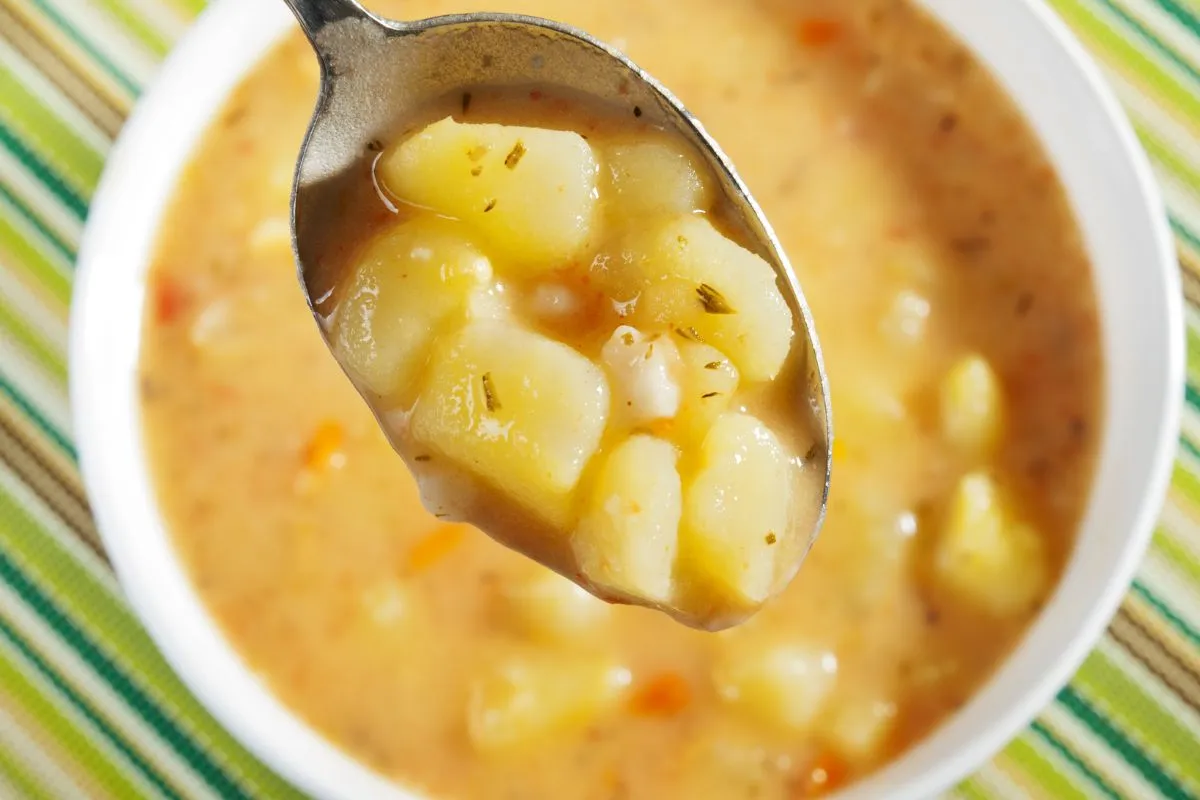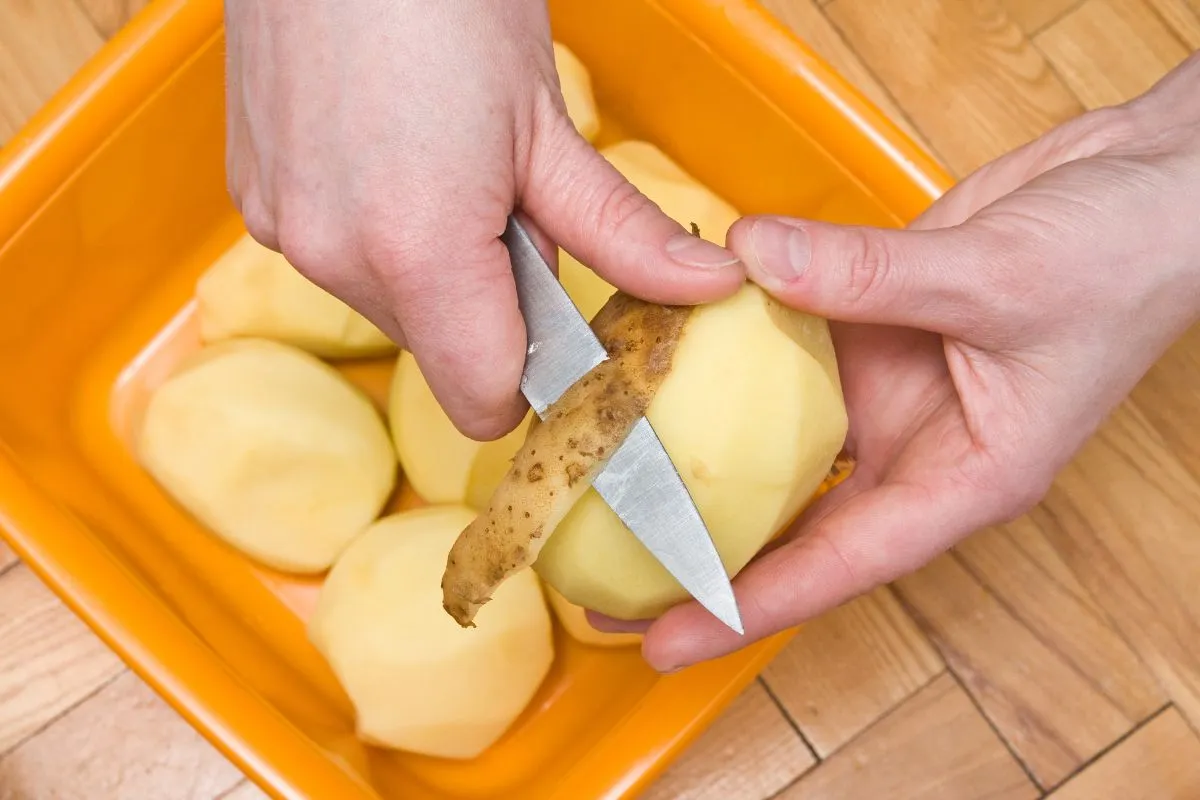Introduction to Thickening Potato Soup
The art of making potato soup—a comforting, creamy staple in many cuisines—is one that balances flavor and texture to achieve a dish that’s both satisfying and delicious. The key to its success often lies in achieving the perfect consistency. Thickening potato soup is an essential step that transforms a watery broth into a rich, velvety masterpiece. This introduction will explore the importance of thickness in potato soup and how to achieve it, focusing on the 4 ingredient potato soup and expanding upon it.
The Importance of Achieving the Right Consistency
In the realm of potato soup, the texture is just as important as the taste. A properly thickened soup offers a luxurious mouthfeel that enhances the overall dining experience. It’s the difference between a dish that feels hearty and comforting versus one that’s forgettable. Achieving the right consistency in your 4 ingredient potato soup can turn a simple meal into a standout dish.
- Satisfaction: A thicker soup is more satisfying and filling, making it a perfect meal for cold days.
- Flavor Depth: Thicker soups tend to hold and carry flavors better, allowing each spoonful to be packed with taste.
- Presentation: Visually, a thickened soup has a more appealing texture, making it look as good as it tastes.
Techniques for Thickening Potato Soup
Several methods can be employed to thicken potato soup, each bringing its unique benefits to the table. Here are the most effective techniques:
- Using Potatoes: The simplest method is to use the potatoes themselves. By blending or mashing a portion of the cooked potatoes, you naturally thicken the soup.
- Roux: A mixture of flour and butter cooked together before being added to the soup can provide thickness and a hint of nutty flavor.
- Cornstarch Slurry: A gluten-free option involves mixing cornstarch with water and stirring it into the soup, thickening it without altering the flavor.
- Cream or Milk: Adding dairy not only thickens the soup but also adds a creamy texture and richness.
- Cheese: Melting cheese into the soup can thicken it while adding depth and a silky texture.
Adjusting Thickness to Preference
Achieving the perfect thickness for your potato soup is a matter of personal preference. Here are some tips for adjusting the consistency:
- Gradual Additions: When using thickeners like roux or cornstarch, add them gradually to avoid making the soup too thick.
- Blending: If the soup is too thick after blending, you can thin it out with a little broth or water until you reach the desired consistency.
- Simmering: Allow the soup to simmer uncovered to reduce and thicken if it’s still too thin after employing other methods.
Understanding Soup Consistency
The journey to a perfect bowl of potato soup often begins with achieving the desired consistency. Whether you crave a velvety smooth texture or a heartier, thicker stew, understanding the factors that influence soup thickness is essential. Here, we delve into the science behind soup thickness, highlighting the role of starch content and various cooking techniques.

The Science Behind Soup Thickness
At the heart of soup-making is a simple yet profound science that determines the final texture of your dish. Soup thickness is primarily governed by two factors: the starch content of your ingredients and the cooking methods you employ.
- Starch Content: Potatoes naturally contain starch, a carbohydrate that swells and absorbs water or any other cooking liquid upon heating. This swelling action thickens the soup, giving it body and a creamy texture. The type of potato used can significantly affect the soup’s consistency. For instance, russets and other starchy potatoes lend themselves well to a thicker soup, while waxy varieties like red or new potatoes may result in a thinner consistency.
- Cooking Techniques: The way you cook your soup also plays a crucial role in how thick it becomes. Techniques include:
- Simmering: Allows the starches in the potatoes to release slowly, gradually thickening the soup.
- Blending: Pureeing part of the soup can instantly thicken it, adding creaminess without additional thickeners.
- Roux: A mixture of flour and fat cooked together before adding to the soup, this classic thickening agent adds both thickness and flavor.
- Reduction: Simply allowing your soup to simmer uncovered can reduce the liquid content, concentrating the flavors and naturally thickening the broth.
Achieving the perfect thickness in potato soup is both an art and a science, requiring a balance of the right ingredients and techniques. By understanding the underlying principles of soup consistency, home cooks can master the art of making a potato soup that’s just right for their taste.
In crafting a potato soup that delights the senses, remember that the key lies in balancing the natural starches with your chosen thickening techniques. Whether you’re aiming for a light and brothy soup or a thick and creamy chowder, the journey to perfection is paved with knowledge and experimentation. Keep these principles in mind, and you’ll find that perfecting the consistency of your potato soup is a rewarding endeavor that elevates your culinary creations.
Common Thickening Agents
Thickening agents play a crucial role in achieving the perfect texture for potato soup. Whether you prefer a silky smooth consistency or a heartier feel, understanding how to use these agents effectively is key. Below, we explore several options, each offering unique benefits to your culinary creations.
Flour: The Foundation of a Roux
- Overview: Flour is a traditional thickener, often used to create a roux. A roux is a mixture of flour and fat cooked together until smooth.
- How to Make a Roux: Start by melting butter in a pan, then add an equal amount of flour. Stir continuously over medium heat until the mixture becomes paste-like and lightly golden. This cooked mixture, when added to your soup, not only thickens it but also adds a depth of flavor.
- Benefits: Ideal for creating a rich, velvety texture in potato soup. It’s also a versatile base for other dishes.
Cornstarch: A Clear Thickener
- Creating a Slurry: Cornstarch must first be mixed with cold water to form a slurry. This prevents lumps when added to the hot soup.
- Instructions: Mix one part cornstarch with two parts cold water. Stir until smooth, then slowly incorporate into the simmering soup, stirring continuously until thickened.
- Benefits: Cornstarch is a gluten-free option that thickens without clouding the soup, preserving the dish’s visual appeal.
Potato Starch: Gluten-Free Thickening
- Usage: Similar to cornstarch, potato starch should be mixed with cold water before being added to the soup.
- Advantages: It’s an excellent choice for those requiring gluten-free options. Potato starch adds a silky texture to the soup without altering the flavor profile.
Instant Potatoes: Quick and Convenient
- How to Use: Instant potato flakes can be stirred directly into the soup to thicken it without the need for pre-mixing.
- Quick Fix: This method is incredibly convenient and uses a potato-based product to enhance the potato flavor of the soup. It’s perfect for adjusting the thickness of your soup at the last minute.
Incorporating these thickening agents into your potato soup allows for a range of textures, from light and brothy to thick and creamy. Understanding how to effectively use flour, cornstarch, potato starch, and instant potatoes gives you the flexibility to create the perfect potato soup consistency every time. Experiment with these agents to discover the texture that best suits your taste. Remember, the key to a successful thickening agent is not just in its ability to thicken but also in how it complements the flavors of your dish.
Advanced Thickening Techniques
Mastering the art of thickening potato soup can transform a simple meal into an exquisite culinary experience. Beyond the basic methods, there are advanced techniques that not only enhance the thickness but also the flavor and richness of the soup. These creative strategies cater to the 4 ingredient potato soup, elevating its texture and adding layers of taste that make each spoonful a delight.

Creative Ways to Thicken Potato Soup
Blending Part of the Soup to Add Body
- Technique: Use an immersion blender to puree part of the cooked potatoes directly in the pot. Alternatively, transfer a portion of the soup to a blender, process until smooth, and then mix back in.
- Benefits: This method utilizes the soup’s own ingredients to thicken it, ensuring that the flavor remains consistent and the texture becomes creamier without the addition of extra ingredients.
Using Heavy Cream or Cheese for Richness and Thickness
- Heavy Cream: Adding heavy cream introduces a luxurious texture and a subtle sweetness that enhances the soup’s base.
- Cheese: Stir in grated cheese, such as cheddar or Parmesan, until melted. Cheese not only thickens the soup but also adds a savory depth of flavor.
- Application: Incorporate these dairy products after the soup has been blended to your desired consistency, allowing them to meld seamlessly with the warm mixture.
Incorporating Vegetable Purees for Added Flavor and Consistency
- Selection: Consider purees from vegetables like cauliflower, pumpkin, or sweet potatoes. These vegetables not only thicken the soup but also complement the potato’s natural flavor.
- Preparation: Roast or boil the additional vegetables until tender, then puree them before adding to the soup. This step can be done simultaneously with the cooking of the potatoes or as a separate process.
- Advantages: Vegetable purees introduce complex flavors and additional nutritional benefits, making the soup a more wholesome option.
These advanced methods not only improve the texture but also infuse the soup with intricate flavors, making each bite a testament to the versatility and depth that can be achieved with simple ingredients. Whether you’re aiming for a velvety smoothness or a rich, hearty consistency, these techniques offer the tools to create a potato soup that’s as comforting as it is satisfying.
Dairy and Non-Dairy Variations
In the quest to perfect 4 ingredient potato soup, the challenge often lies in achieving a creamy consistency without relying solely on traditional dairy products. This becomes particularly important for those following vegan diets or for individuals with dairy sensitivities. Fortunately, the culinary world has embraced a variety of dairy substitutes that can mimic the texture and richness of milk or cream, providing ample options for thickening potato soup without compromising on taste or texture.
Dairy Substitutes for Vegan Potato Soup
The move towards plant-based eating has popularized several dairy alternatives. These substitutes not only cater to dietary restrictions but also add unique flavors and nutritional profiles to the classic potato soup. Here are some of the most effective dairy substitutes:
Coconut Milk
- Characteristics: Coconut milk offers a creamy texture and a subtly sweet, tropical flavor that can complement the savory notes of potato soup.
- Application: Use full-fat coconut milk for the best creaminess. Add it towards the end of cooking to prevent curdling and to fully incorporate its rich texture.
- Benefits: Besides being dairy-free, coconut milk is rich in vitamins and minerals, adding a nutritional boost to the soup.
Almond Milk
- Characteristics: Almond milk is lighter than coconut milk and offers a nutty flavor. It’s a great option for those seeking a less rich dairy substitute.
- Application: Opt for unsweetened and unflavored almond milk to avoid altering the soup’s taste. It can be added in the same quantity as traditional milk.
- Benefits: Low in calories and containing no saturated fat, almond milk makes for a healthier option while still providing a smooth texture.
Cashew Cream
- Preparation: Cashew cream is made by blending soaked cashews with water until smooth. The result is a rich, creamy liquid that’s perfect for thickening soups.
- Characteristics: It has a neutral flavor, making it an excellent base for soups, and it mimics the mouthfeel of heavy cream.
- Application: Stir in cashew cream during the last few minutes of cooking, allowing it to warm through and thicken the soup without boiling.
- Benefits: Cashew cream adds a dose of healthy fats, protein, and magnesium.
Lower-Calorie Options for Thickening Potato Soup
Crafting a heartwarming bowl of potato soup that’s both satisfying and low in calories is a delightful challenge. With innovative techniques and ingredients, achieving a rich texture and flavor without the extra calories becomes possible.
Embrace Cauliflower Puree for Creaminess
One effective strategy to lower the calorie content without sacrificing the soup’s thickness involves using cauliflower puree. Cauliflower, once cooked and blended, offers a creamy texture akin to traditional potato soup.
Discover the Lightness of Broth
The choice of broth significantly impacts the soup’s consistency and calorie content. Opting for low-sodium, vegetable, or chicken broth enhances the flavor while managing calories. This approach keeps the soup light yet flavorful, catering to various dietary needs.
Utilizing Cauliflower as a Thickener
Cauliflower shines as a low-calorie, versatile vegetable that, when pureed, introduces creaminess to soups. Its neutral taste allows the soup’s main flavors to stand out, ensuring a comforting and hearty experience. For practical tips and more details about cauliflower check out CAULIFLOWER & ROMANESCO article.
Broth’s Role in Fine-Tuning Consistency
Leveraging broth effectively is key to enhancing flavor and controlling the soup’s nutritional profile. It allows for a reduction in calorie density while preserving the soup’s robust character. Employing broth strategically can align the soup with various dietary preferences, ensuring it remains a versatile and welcoming dish for all.
FAQ: Thickening Potato Soup and More
When it comes to enhancing and troubleshooting your 4 ingredient potato soup, or any soup for that matter, several questions often arise. Here, we’ll tackle some of the most frequently asked questions, focusing on achieving the perfect consistency and flavor.
What Is the Most Important Ingredient in Soup?
- While it may vary by recipe, the base or stock is often considered the most important ingredient in soup. It lays the foundation for the flavor profile and depth of the soup, whether it’s vegetable, chicken, beef, or another type.
Can I Use Instant Mashed Potatoes to Thicken Soup?
- Yes, instant mashed potatoes can be an effective thickener for potato soup. They’re convenient and blend well, offering a quick way to adjust the soup’s thickness without altering its flavor significantly.
- How to Use: Gradually stir in small amounts of instant mashed potatoes until you reach the desired consistency, allowing the soup to simmer briefly as it thickens.
How Do I Fix Potato Soup That’s Too Thin?
- Blending: Puree a portion of the soup to naturally thicken it without adding extra ingredients.
- Roux or Slurry: Prepare a roux with equal parts flour and butter, or make a slurry with cornstarch and water, then stir it into the soup.
- Additional Ingredients: Incorporate more potatoes, instant mashed potatoes, or dairy/non-dairy cream to enhance thickness.
What Is the No 1 Soup in the World?
- There’s no definitive answer, as preferences vary globally, but tomato soup is frequently cited as one of the most popular and beloved soups around the world due to its comforting nature and versatility.
What Makes Soup More Tasty?
- Seasoning: Properly seasoning your soup with salt, pepper, and herbs can dramatically enhance its flavor.
- Acid: Adding a splash of lemon juice or vinegar can brighten the soup and balance its flavors.
- Umami: Ingredients like mushrooms, tomato paste, and soy sauce can add depth and a savory umami quality.
- Freshness: Garnishing with fresh herbs or green onions before serving can add a burst of freshness and color.
Conclusion
Creating a heartwarming bowl of potato soup that’s both indulgent and mindful of calorie intake is an artful balancing act. By embracing innovative ingredients like cauliflower puree and making thoughtful choices such as utilizing low-sodium broths, it’s possible to craft a soup that’s rich in flavor and texture without the added calories. These strategies not only cater to a broader range of dietary preferences but also enhance the soup’s nutritional profile, making it a guilt-free comfort food.
Whether you’re looking to maintain a low-calorie diet or simply seeking a healthier alternative to traditional thickening agents, the versatility of cauliflower and the careful selection of broth prove that you can enjoy the creamy, comforting essence of potato soup in a lighter, more health-conscious form. This approach to soup-making not only elevates the dish’s culinary value but also its place in a balanced diet, proving that comfort food can be both satisfying and wholesome.

